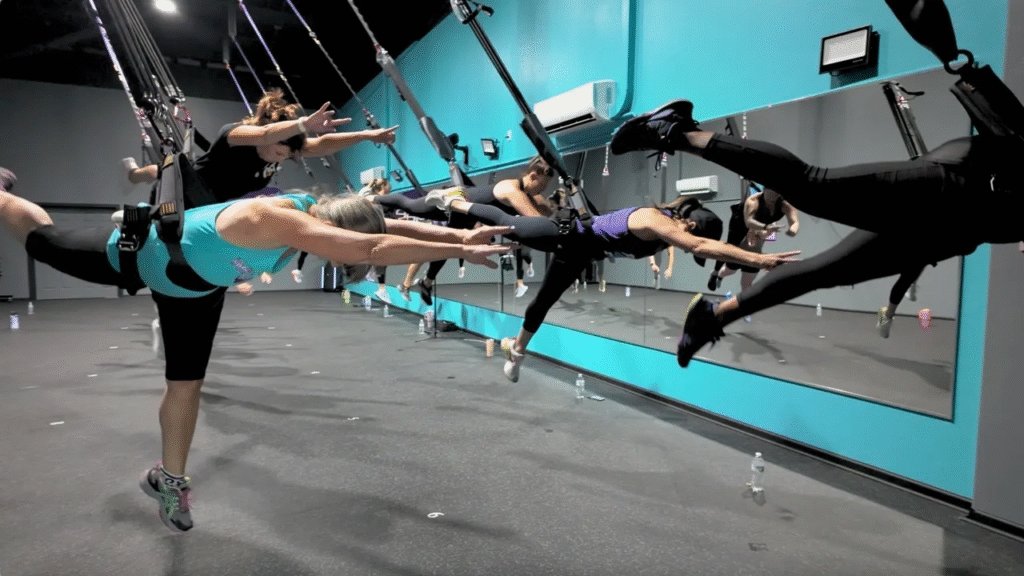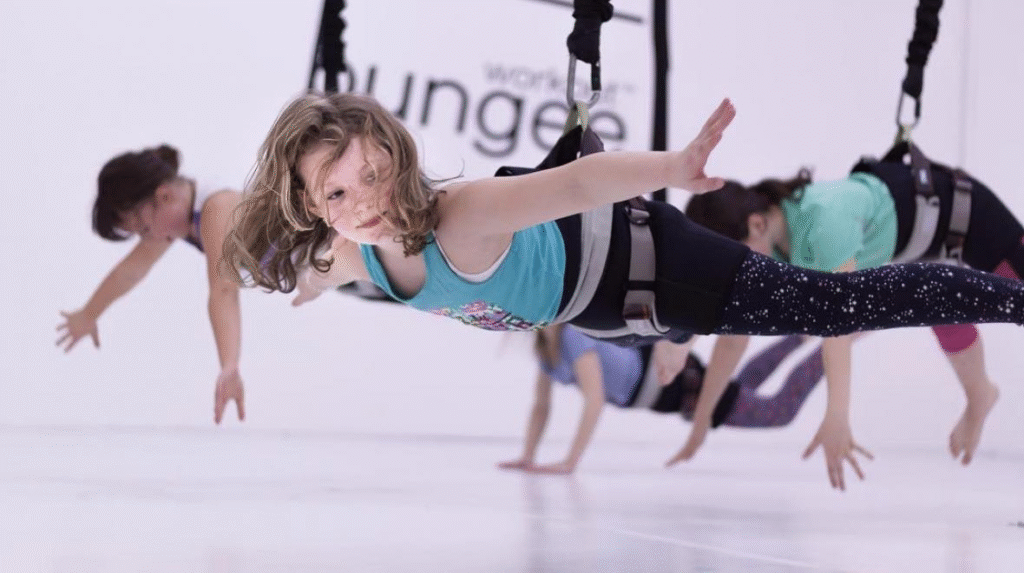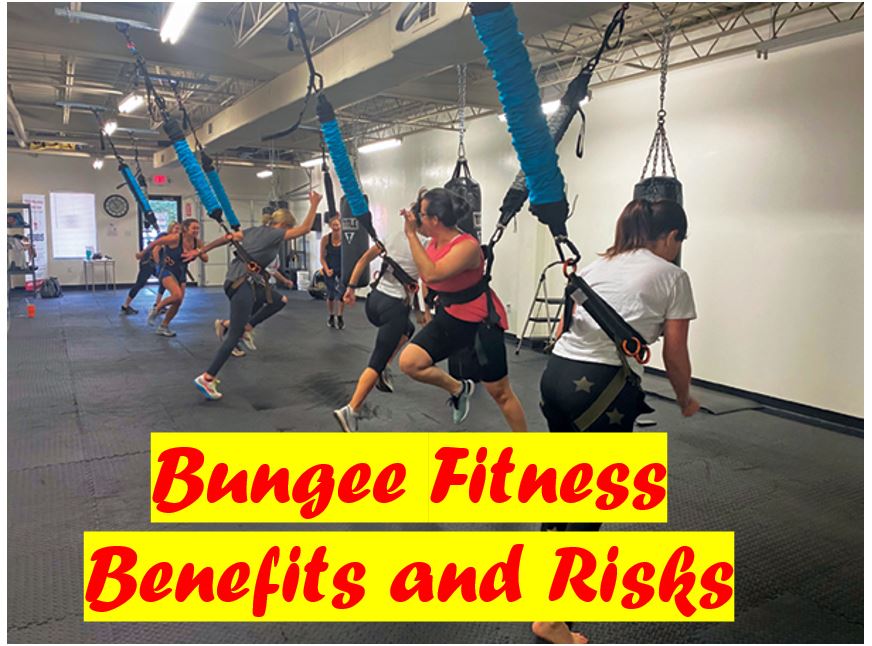Bungee fitness is a dynamic and low-impact form of exercise that involves wearing a harness attached to a bungee cord suspended from the ceiling. The resistance of the cord enables participants to jump, bounce, and glide through choreographed movements with ease and reduced impact on the joints. As it gains popularity in fitness communities around the world, it’s important to consider both the benefits and risks involved in this type of workout. In this article, we will explore the physical, mental, and functional advantages of bungee fitness, as well as the potential drawbacks and safety concerns.

Benefits of Bungee Fitness
1. Low-Impact on Joints
One of the biggest advantages of bungee fitness is that it is a low-impact workout. The bungee harness absorbs much of the impact from movements such as jumping, lunging, or falling, reducing the stress placed on joints, tendons, and ligaments. This makes bungee fitness ideal for individuals with arthritis, previous injuries, or joint sensitivities. It also allows participants to perform high-intensity movements without the typical wear and tear associated with conventional cardio or strength exercises like running or jumping jacks.
2. Full-Body Workout
Although bungee fitness might look like fun and games, it provides a serious full-body workout. Classes are designed to incorporate elements of cardio, strength training, core engagement, and flexibility. The resistance of the bungee cord adds an extra challenge to movements, forcing the body to stabilize itself throughout the routine. As a result, participants work their glutes, abs, shoulders, arms, back, and legs simultaneously, which can lead to improved muscle tone and better functional strength over time.
3. Cardiovascular Conditioning
The continuous movement in bungee workouts boosts heart rate and improves cardiovascular endurance. Whether you are bouncing, squatting, sprinting in place, or doing aerial routines, your body works hard to maintain momentum and balance. For those aiming to lose weight or enhance their aerobic capacity, bungee fitness offers a fun and effective way to reach cardiovascular goals without the monotony of traditional treadmill workouts or cycling.
4. Improved Balance and Coordination
Bungee workouts challenge your proprioception—the body’s sense of its position in space—by requiring you to constantly stabilize and correct your posture. Moving against the resistance of the bungee cord while maintaining control improves coordination, balance, and spatial awareness. These skills are transferable to daily life and can be especially valuable for older adults or individuals in rehabilitation.
5. Increased Core Engagement
Because participants are tethered to a single point of resistance and often off-balance, nearly every movement in a bungee class demands core stabilization. This constant engagement of the abdominal and lower back muscles helps improve posture, reduce lower back pain, and develop core strength—all of which are essential for overall health and injury prevention.

6. Psychological Benefits
Bungee fitness is not just physically rewarding; it’s also a mental boost. The sense of flying or floating can be liberating and uplifting, helping to reduce stress, anxiety, and mental fatigue. Many participants find that the joyful, almost playful nature of bungee fitness improves their mood and increases motivation to exercise. The novelty of the workout can also break through exercise boredom and reignite enthusiasm for physical activity.
7. Accessibility for a Range of Fitness Levels
Bungee fitness can be adapted to various fitness levels and physical abilities. Instructors are typically trained to modify movements and tension levels according to each participant’s needs. Beginners can start with simple routines, while more advanced users can perform complex aerial maneuvers. This scalability makes it suitable for people just starting their fitness journey, as well as seasoned athletes looking for a new challenge.
Risks and Considerations of Bungee Fitness
1. Initial Discomfort and Bruising
A common complaint among beginners is discomfort from the harness, especially in the hips, thighs, and lower back. Because the harness must be snug to function correctly, it can cause chafing, pressure marks, or even bruising in the early stages. While this typically subsides with repeated use and proper adjustment, it can be off-putting for first-timers. Wearing appropriate padded clothing or adjusting the harness correctly can mitigate this issue.
2. Learning Curve and Risk of Falling
Bungee fitness requires a level of coordination and body awareness that may not come naturally to everyone. New participants may struggle with maintaining balance or timing their movements with the resistance of the cord. Incorrect movements can lead to minor falls, awkward landings, or sprains, particularly if a participant pulls against the cord too forcefully or lets it snap them back without control. Proper instruction and supervision are crucial in preventing these mishaps.
3. Equipment Malfunction or Improper Setup
As with any fitness activity involving equipment, there’s a risk of malfunction. Faulty harnesses, improperly secured cords, or inadequate ceiling mounts can lead to accidents or injuries. It is essential for studios to follow strict safety protocols, including regular inspection and maintenance of all gear. Participants should never attempt bungee fitness outside a professionally equipped and supervised environment.
4. Not Suitable for All Body Types
Bungee fitness equipment typically comes with weight and height restrictions. Most harnesses are rated for users up to a certain weight (often around 250 pounds), and individuals outside of this range may not be able to safely participate. In addition, those with certain medical conditions—such as severe osteoporosis, heart conditions, or vertigo—should consult a physician before trying bungee fitness.
5. Limited Availability and Cost
Despite its growing popularity, bungee fitness is still a niche offering. Not every city has a studio equipped for it, and installing a personal system at home can be expensive and logistically complex. Class pricing can also be higher than traditional gym memberships, ranging from $15 to $35 per class depending on location and package. This may limit access for some individuals, especially in underserved areas.
6. Overuse Injuries
Although bungee fitness is low-impact, repetitive movement or excessive participation without adequate rest can still lead to overuse injuries, especially in the shoulders, knees, and lower back. As with any form of exercise, it’s important to balance bungee workouts with rest days and cross-training to avoid strain.

Conclusion
Bungee fitness represents a refreshing shift in the fitness industry, combining playfulness with performance. Its appeal lies in its ability to deliver a full-body, low-impact, high-intensity workout that feels more like fun than effort. For many, the experience of defying gravity provides a unique mix of physical and psychological benefits, from enhanced muscle tone and cardiovascular health to improved mood and motivation.
However, like any fitness method, it is not without risks. The physical demands, learning curve, and equipment considerations mean that bungee fitness is best approached under professional supervision and with realistic expectations. For those able to access it and physically suited to participate, bungee fitness can be a transformative and highly enjoyable way to stay active and healthy. Whether you’re a beginner looking for a joint-friendly option or an experienced exerciser in search of variety, bungee fitness offers a high-flying alternative worth considering.






One thought on “What are the Benefits and Risks of Bungee fitness?”